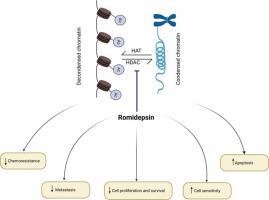Biomedicine & Pharmacotherapy ( IF 6.9 ) Pub Date : 2023-05-22 , DOI: 10.1016/j.biopha.2023.114774 Nasreddine El Omari 1 , Learn-Han Lee 2 , Saad Bakrim 3 , Hafiz A Makeen 4 , Hassan A Alhazmi 5 , Syam Mohan 6 , Asaad Khalid 7 , Long Chiau Ming 8 , Abdelhakim Bouyahya 9

|
Romidepsin, also known as NSC630176, FR901228, FK-228, FR-901228, depsipeptide, or Istodax®, is a natural molecule produced by the Chromobacterium violaceum bacterium that has been approved for its anti-cancer effect. This compound is a selective histone deacetylase (HDAC) inhibitor, which modifies histones and epigenetic pathways. An imbalance between HDAC and histone acetyltransferase can lead to the down-regulation of regulatory genes, resulting in tumorigenesis. Inhibition of HDACs by romidepsin indirectly contributes to the anticancer therapeutic effect by causing the accumulation of acetylated histones, restoring normal gene expression in cancer cells, and promoting alternative pathways, including the immune response, p53/p21 signaling cascades, cleaved caspases, poly (ADP-ribose) polymerase (PARP), and other events. Secondary pathways mediate the therapeutic action of romidepsin by disrupting the endoplasmic reticulum and proteasome and/or aggresome, arresting the cell cycle, inducing intrinsic and extrinsic apoptosis, inhibiting angiogenesis, and modifying the tumor microenvironment. This review aimed to highlight the specific molecular mechanisms responsible for HDAC inhibition by romidepsin. A more detailed understanding of these mechanisms can significantly improve the understanding of cancer cell disorders and pave the way for new therapeutic approaches using targeted therapy.
中文翻译:

罗米地辛抗癌疗效的分子机制
罗米地辛,也称为 NSC630176、FR901228、FK-228、FR-901228、缩肽或 Istodax®,是由紫色色杆菌产生的天然分子已被批准具有抗癌作用的细菌。该化合物是一种选择性组蛋白脱乙酰酶 (HDAC) 抑制剂,可修饰组蛋白和表观遗传途径。HDAC 和组蛋白乙酰转移酶之间的不平衡会导致调节基因的下调,从而导致肿瘤发生。罗米地辛对 HDAC 的抑制通过引起乙酰化组蛋白的积累、恢复癌细胞中的正常基因表达以及促进替代途径(包括免疫反应、p53/p21 信号级联、裂解的半胱天冬酶、聚(ADP))间接有助于抗癌治疗效果。 -核糖)聚合酶(PARP)和其他事件。次要途径通过破坏内质网和蛋白酶体和/或聚集体、阻止细胞周期来介导罗米地辛的治疗作用,诱导内在和外在的细胞凋亡,抑制血管生成,并改变肿瘤微环境。本综述旨在强调罗米地辛抑制 HDAC 的具体分子机制。更详细地了解这些机制可以显着提高对癌细胞疾病的理解,并为使用靶向治疗的新治疗方法铺平道路。






























 京公网安备 11010802027423号
京公网安备 11010802027423号